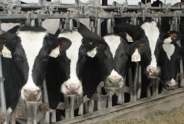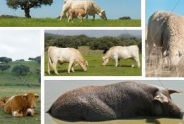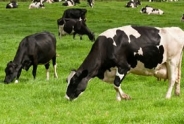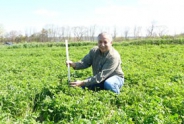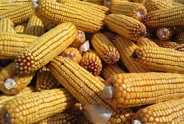Would a National Checkoff fit Organic?
A. Fay Benson, Small Dairy Extension Educator
South Central New York Dairy & Field Crops
January 6, 2014
What is a National Checkoff Program?by Elizabeth Burrichter, Organic Dairy Educator, Cortland County CCE
Do the sayings, 'Got Milk?', 'Beef: It's What's for Dinner,' or 'Pork. The Other White Meat' sound familiar? These promotions are all part of National Research and Promotion Programs, also known as commodity checkoff programs. These programs, overseen by the USDA, collect funds, called checkoff dollars or assessments, from producers, handlers or processors of a particular agricultural commodity. The goal of these programs is to maintain and expand existing markets, as well as to develop new markets. Some checkoff programs also fund agricultural production research.
The Organic Trade Association (OTA) has lobbied for such a program to promote the organic industry and distinguish it in the marketplace. The OTA believes that a major challenge for the organic sector is consumer confusion about what organic stands for, and this program would seek to help the consumer understand all that organic delivers through collective resources and coordination.
Unfortunately, the organic community is split on their support of this idea for an organic checkoff program.
Hurdles to such a program:
- Currently, 100 percent organic operations are exempt from any checkoff assessments under the 2002 Amendment.
- Before an organic checkoff program could take place, organic products would have to become a single commodity. The Commodity Promotion, Research, and Information Act of 1996 does not allow for more than one commodity to be part of a checkoff program, but OTA's proposal is to change that Act so that organics could become a single commodity.
- Several checkoff programs include a research component as an output, but because of the breadth of products included in this organic program, the research component would be the weakest link in the proposal. If all organic products are a single commodity, then research dollars would need to be spread evenly across every different production system. The diversity within organic production, i.e. field crops, orchards, vineyards, greenhouse production, etc., would prohibit the possibility of conducting thorough production research across all organic fields, which would be extremely expensive. Since production research would not be the main output of this program, funds would be focused on promoting organic products.
- Creating a conflict of interest is prohibited within the program. This means that all promotion must be generic, and that promotion cannot disparage another agricultural commodity. Funds cannot influence governmental action or policy or "pass through" the program in order to fund another organization. Any promotion that results from an organic checkoff program cannot promote organic food as better than conventional, but can explain exactly what organic certification entails as a production claim.
The current Farm Bill proposal addresses some of the hurdles to an organic checkoff program, with identical language in both the House and Senate versions. This text would allow for a â??technical fixâ?? in the regulatory language so that all split operations (farms that produce both organic and conventional products) would be exempt from conventional checkoff assessments, and not just operations that are 100% organic. Those opposed to the checkoff at the NY Organic Dairy Task Force meeting were in fact supportive of this measure.
While an organic checkoff program directed at consumer education sounds like a good idea, in actuality it would be very difficult and costly to attempt. Those involved in the organic dairy market know it was not created by a clever media campaign from Madison Avenue. It was created by dairy consumers demanding an alternative to milk from cows treated with Bst which began in 1994. How best to keep the trust of consumers is something every organic farmer should invest interest. To weigh in on the subject farmers can go to one of the websites listed below or they can go directly to their elected official in Washington.
http://www.ota.com/ORPP.htmlhttp://www.nodpa.com/checkoff_opposition.shtml
The New York Organic Dairy Task Force has been funded by the New York Farm Viability Institute since 2005. The Task Force is comprised of both organic dairy and crop farmers, certifiers, processors, and related support services. They meet twice a year and review opportunities and barriers to the organic dairy industry in New York. For more information go to: http://cuaes.cornell.edu/organic/projects/dairy/dairy-initiative/
Upcoming Events
North American Manure Expo
July 17 - July 18, 2024 : North American Manure Expo
Auburn, NY
Save the Date for the North American Manure Expo
Professionalism in Nutrient Management - www.manureexpo.com
Sundaes on the Farm
July 21, 2024
Spencer, NY
Learn about Tioga County Agriculture! IFree Admission! Enjoy Ice Cream, Animals and Farm Tours, Kid's Activities, Food, Live Music, and Farm Vendors.
Announcements
Farm Participants Needed for Bale Grazing Grant!
Information on the Project:- Approximately 10 acres total needed to bale graze two different bale densities
- "Core" farms will graze two winters, "Demo" farms will graze one winter.
- Payments for both "Core" farms and "Demo" farms
- Baseline soil sampling by bale grazing team
- Forage measurements in early season by bale grazing team
- Late season clipping if residual not trampled down by farm
Interested farms can enroll for this winter or next.
Looking for 2-3 dairy farms to enroll! If interested, please reach out to Betsy Hicks, 607.391.2673 or bjh246@cornell.edu
Cornell Cow Convos - New Podcast
On-going podcast, New episodes released on the last Thursday of the month.Guest speakers, CCE Dairy Specialists.
Housed on Soundcloud Channel is CCE Dairy Educators
Topics:
- Preventative healthcare for cows
- The trend of beef on dairy
- What to look forward to in the new year for dairy
- Socially grouping or pair-housing calves
Dairy Acceleration Program Funds Available
Funds available for the
- organization of financial records/benchmarking up to $1,000
- continued business planning (for farms awarded in a previous year) up to $2,500
- business planning up to $5,000
2018 Drug Residue Prevention Manual
For more than 30 years, the U.S. dairy industry has focused educational efforts on the judicious use of antibiotics through the annual publication of a Best Practices Manual. The 2018 edition of the National Dairy FARM Program: Farmers Assuring Responsible Management? Milk and Dairy Beef Drug Residue Prevention Manual is the primary educational tool for dairy farm managers throughout the country on the judicious and responsible use of antibiotics, including avoidance of drug residues in milk and meat.The manual is a quick resource to review those antibiotics approved for dairy animals and can also be used as an educational tool and resource for farm managers as they develop on-farm best management practices necessary to avoid milk and meat residues. Visit the Manual and Form Library to download copies of this important tool!
Follow us on Facebook
The team updates our facebook page frequently - follow us to be updated on our events, see some fun videos and get local area updates!facebook.com/SCNYDairyandFieldCropsTeam
ProDairy Forage Management
Are you prepared to change your routine this spring?By: Joe Lawrence, Cornell CALS PRO-DAIRY and Ron Kuck, Cornell Cooperative Extension North Country Regional Ag Team
While spring tasks vary by farm, there are many "rites of spring," and they are often completed in a fairly rigid sequence. Depending on the farm, these often include fixing fence, spreading manure, planting new seedings, planting corn and harvesting first cutting, and are often performed in this order.
We are optimistic that the upcoming turn in weather will allow these task to be accomplished in a timely manner, but at this point it is time to ask yourself: Are you willing to change your spring routine?
In addition to adverse weather it is no secret that everyone is facing extremely tight economic times, and dealing with forage inventories of poor digestibility forages from 2017. This combination of factors makes it more critical than ever to be ready to tackle the task that will have the most impact on your business at the proper time.
Recent reference articles on dealing with tough times:
• Key Opportunities to Optimize 2018 Crop Production Efficiency
• Resources for Dealing with Spring Weather Delays
First Cutting
The number one focus should be on timely harvest of first cutting.
• Park the corn planter when a field of first cutting is ready for harvest.
o Monitoring 1st cut harvest timing
• Approach harvest by the acre, not by the field. Be ready to skip over a field that has passed its optimum harvest stage.
o Dynamic Harvest Schedules
• Strategically plan feed storage to best utilize forage inventories for the right group of animals.
o Strategic Forage Storage Planning
o When More is Better
Corn Planting
The window for planting for silage is generally wider than for grain, which is why first cutting can and should take priority over corn planting. However, in the event of extreme delays in planting corn, performance will diminish with late plantings. If corn planting progresses into late May or early June, begin to consider alternative options for those acres. Previous research from Cornell and Penn State suggest a 0.5 to 1 ton/acre per week decline in silage yield for planting after mid to late May.
Multi-Tasking
First and foremost during a time of year that can be very busy and stressful, taking every precaution to keep your team safe is critical.
The idea of fitting all of this work into a condensed time period, and still getting key tasks completed before critical deadlines can seem impossible, but year after year many find unique ways to get it all done. Consider working with neighbors, custom operators or renting equipment to accomplish these key tasks on time.
If you currently utilize custom operators, now is a good time to set up a time to meet with them and make sure you are on the same page to get tasks accomplished in the time-frame needed. Make sure that your expectations and goals are clearly defined. They will also be under stress to fit their work into a condensed period and meet their customers' expectations, so defining expectations and pre-planning how to most efficiently get the work accomplished when the custom operator arrives can go a long way to increase the chances for success.
While spring tasks vary by farm, there are many "rites of spring," and they are often completed in a fairly rigid sequence. Depending on the farm, these often include fixing fence, spreading manure, planting new seedings, planting corn and harvesting first cutting, and are often performed in this order.
We are optimistic that the upcoming turn in weather will allow these task to be accomplished in a timely manner, but at this point it is time to ask yourself: Are you willing to change your spring routine?
In addition to adverse weather it is no secret that everyone is facing extremely tight economic times, and dealing with forage inventories of poor digestibility forages from 2017. This combination of factors makes it more critical than ever to be ready to tackle the task that will have the most impact on your business at the proper time.
Recent reference articles on dealing with tough times:
• Key Opportunities to Optimize 2018 Crop Production Efficiency
• Resources for Dealing with Spring Weather Delays
First Cutting
The number one focus should be on timely harvest of first cutting.
• Park the corn planter when a field of first cutting is ready for harvest.
o Monitoring 1st cut harvest timing
• Approach harvest by the acre, not by the field. Be ready to skip over a field that has passed its optimum harvest stage.
o Dynamic Harvest Schedules
• Strategically plan feed storage to best utilize forage inventories for the right group of animals.
o Strategic Forage Storage Planning
o When More is Better
Corn Planting
The window for planting for silage is generally wider than for grain, which is why first cutting can and should take priority over corn planting. However, in the event of extreme delays in planting corn, performance will diminish with late plantings. If corn planting progresses into late May or early June, begin to consider alternative options for those acres. Previous research from Cornell and Penn State suggest a 0.5 to 1 ton/acre per week decline in silage yield for planting after mid to late May.
Multi-Tasking
First and foremost during a time of year that can be very busy and stressful, taking every precaution to keep your team safe is critical.
The idea of fitting all of this work into a condensed time period, and still getting key tasks completed before critical deadlines can seem impossible, but year after year many find unique ways to get it all done. Consider working with neighbors, custom operators or renting equipment to accomplish these key tasks on time.
If you currently utilize custom operators, now is a good time to set up a time to meet with them and make sure you are on the same page to get tasks accomplished in the time-frame needed. Make sure that your expectations and goals are clearly defined. They will also be under stress to fit their work into a condensed period and meet their customers' expectations, so defining expectations and pre-planning how to most efficiently get the work accomplished when the custom operator arrives can go a long way to increase the chances for success.
NYSERDA Agriculture Energy Audit Program
NYSERDA offers energy audits to help eligible farms and on-farm producers identify ways to save energy and money on utility bills. Reports include recommendations for energy efficiency measures.Eligibility
Eligible farms include but are not limited to dairies, orchards, greenhouses, vegetables, vineyards, grain dryers, and poultry/egg. The farms must also be customers of New York State investor-owned utilities and contribute to the System Benefits Charge (SBC). Please check your farm’s current utility bills to see if your farm pays the SBC.
Energy Audit Options
You can request the level of energy audit that best fits your farm’s needs. NYSERDA will assign a Flexible Technical Assistance Program Consultant to visit your farm and perform an energy audit at no cost to you.
For more information and the NYSERDA Agriculture Energy Audit Program Application click here
For more information and the NYSERDA Agriculture Energy Audit Program Application click here

